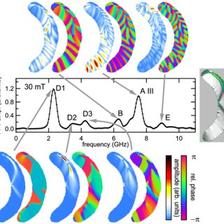Measured spin wave mode spectrum and simulated magnetization dynamics in a curved magnetic nanowire. From J. Phys.: Condens. Matter. 26, 266003 (2014)
The enormous potential of ultrafast spin manipulation for applications in information storage, processing and retrieval stimulates a growing interest in the excited states and non-equilibrium properties of magnetic structures.
The elementary quanta of excitations in an ordered ensemble of magnetic moments are magnons, also known as spinwaves when seen in the wave picture. An accurate knowledge of the spectrum of spinwave excitations is necessary for tailoring the functionality of magnetic nanostructures. The progress in this field is expressed by the rapid growth of magnonics as the research area where artificially structured materials are designed to tailor the magnetic excitation spectrum of the system. Particularly interesting are spin excitations in ultrathin films and magnetic nanostructures where surfaces and interfaces lead to a strong modification of the spinwave spectrum compared to the bulk.
In ferromagnets, the exchange energy (eV) sets the characteristic time scale in the fs-regime, while demagnetization energy (meV) is the prominent interaction in the ps-regime and above. It is interesting to study confined systems where both inter¬actions are involved. Spinwaves in confined ferromagnets are a prototype multi time-scale problem. In the CUI research project C 3.2 “Imaging dynamics of ferromagnetic nanostructures via nuclear resonant diffraction” we want to realize a new experimental approach to resolve spin-wave dynamics in confined geometries on sub-ns timescales with sub-nm spatial resolution.
Our goal is to investigate spin waves in frustrated lateral ferromagnetic nanostructures. Recently artificial spin ice has come into the focus of interest as confined ferromagnetic system. For spin ice, no single minimal energy exists and it is therefore a model system for frustration phenomena reminiscent of the water-ice systems. In geometrically frustrated single-domain magnets the dipole interaction creates a two-dimensional analog to spin ice in crystals. Static imaging of the magnetic moment of individual elements reveals the local accommodation of frustration. The so-called ice rule dictates the energetically favorable configurations although a full compensation of the local stray fields is a priori not possible. In such lattices, spin-wave modes appear prominently in the frequency spectrum of the magnetization excitation amplitude typically between ten and up to hundred GHz. The character of these spin wave excitations and their dispersion relation shall be characterized by vector-network-analyzer ferromagnetic resonance spectroscopy (VNA-FMR) and with measurements at the dynamics beamline P01 at PETRA III. The experiments planned are at the limit of temporal and spatial resolution of conventional magnetic microscopy, but can be realized by nuclear resonant scattering of synchrotron radiation (NRS). Time-resolved NRS is an established tool to deter¬mine the depth-resolved spin structure of magnetic thin films and nanostructures with sub-nm spatial resolution. The technique is intrinsically sensitive to time-dependent processes as magnetic switching and relaxation phenomena.








